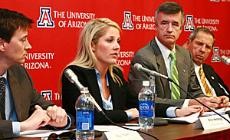A statewide student proposal took center stage at an Arizona Board of Regents tuition hearing last night as student leaders from all three major universities in the state got a mixed reaction from regents.
The forum, which used a live television feed from around the state, gave university presidents and the Arizona Students’ Association a chance to present their proposals to regents publicly for the first time.
Associated Students of the University of Arizona President Erin Hertzog said she is optimistic about the student proposal, which calls for a 2.3 percent tuition increase on the condition that legislators approve a 12 percent hike in funds to the overall state university system.
The plan comes with a clause saying that if legislators do not meet the 12 percent figure, students fully support the increases proposed by their university presidents.
Though she said the proposal is unconventional, Hertzog said it is also “”one of the strongest and most comprehensive proposals ever.””
Michael Huston, a political science junior, said he thinks the proposal is aimed at state legislators who have previously said they want lower tuition at Arizona universities.
“”Let the Legislature put their money where their mouth is,”” Huston said.
A newly revised version of the student proposal calls for the 12 percent, or $115.7 million, increase to exclude a prior commitment from the state for $34.6 million. Those numbers total a $150.3 million requested increase in state funds.
Regent Fred Boice said he thinks it would be hard to convince legislators to increase university funding by such an amount.
“”I can’t imagine the Legislature would give the university system the $115 million and say, ‘Now you guys do whatever you want,'”” Boice said.
But Regent Dennis DeConcini said he fully supports the measure. DeConcini has his own proposal that functions the same as the student proposal but bases its numbers on the national rate of inflation.
By taking the 2.3 percent figure from the rise in median family income in Arizona, DeConcini said students had taken his proposal and “”made it better.””
Boice said he still has to decide whether to approve the students’ plan because he has lingering doubts about what will happen if, for instance, state legislators approve an increase of 11 percent instead of 12 percent.
Financial predictability, especially when it comes time for students and parents to plan for the next academic year, is another of Boice’s concerns.
In previous years, regents set tuition in spring, after legislators had already allocated funds to the state university system, but this year the order is reversed.
Devin Mauney, an ASA board member, said the student tuition proposal would mean universities could count on knowing their budgets for the next year as soon as the statewide budget gets its approval.
But Boice said predictability was one of the main reasons for moving the tuition-setting timeline back to fall, and the student proposal “”flies in the face of that.””
Mauney, an economics sophomore at Arizona State University, said the requested increase in state funding to each university could actually amount to more than the funds from the presidents’ proposals. It would also keep college affordable for students.
“”This plan will give legislators the chance to step up and get what they want,”” Mauney said.
In addition to tuition, Hertzog and Paul Thorn, president of the Graduate and Professional Student Council, presented their views on a technology fee that would go to expanding the campus’ wireless Internet network.
Thorn said he and Hertzog are calling for a $15 increase in the fee rather than the $50 that President Robert Shelton had proposed.
Students have a list of priorities for campus funding, said Steven Gerner, an ASUA senator and political science senior.
“”I can guarantee you, wireless is not at the top of that list,”” Gerner said. “”We don’t feel this fee effectively targets the needs of students.””
Shelton, whose proposal included both tuition and fees, called for a $368 increase for each resident undergraduate and a $411 increase for resident graduates.
Under Shelton’s plan, nonresident undergraduates would pay $1,326 more next year, and nonresident graduate tuition would increase by $1,349.
Shelton said his plan allocates funds in such a way that students would see an “”extraordinary value for the money.””
Heather McCune, a religious studies sophomore, said the cost of an education is daunting for students with difficult financial or family situations.
McCune, who has paid her own way since both of her parents died last year, said working to afford tuition can overwhelm someone’s entire life and may even become more important than going to class.
“”Class becomes a low priority,”” McCune said. “”Life doesn’t stop for college.””









